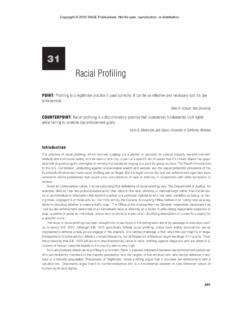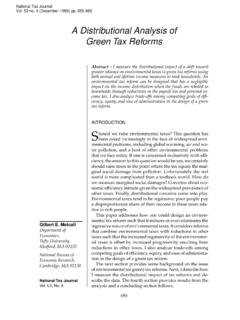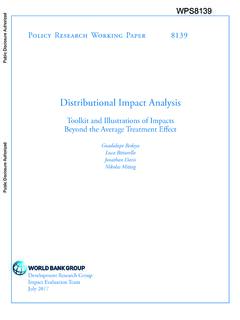Transcription of Distributional Analysis in Educational Evaluation: A Case ...
1 Journal of Research on Educational Effectiveness, 8: 419 450, 2015 Copyright Taylor & Francis Group, LLCISSN: 1934-5747 print / 1934-5739 onlineDOI: Analysis in Educational Evaluation: A CaseStudy from the New York City Voucher ProgramMarianne Bitler, Thurston Domina, and Emily PennerUniversity of California, Irvine, Irvine, California, USAH ilary HoynesUniversity of California, Berkeley, Berkeley, California, USAA bstract:We use quantile treatment effects estimation to examine the consequences of the random-assignment New York City School Choice Scholarship Program across the distribution of studentachievement. Our analyses suggest that the program had negligible and statistically insignificanteffects across the skill distribution. In addition to contributing to the literature on school choice,the article illustrates several ways in which Distributional effects estimation can enrich educationalresearch: First, we demonstrate that moving beyond a focus on mean effects estimation makes itpossible to generate and test new hypotheses about the heterogeneity of Educational treatment effectsthat speak to the justification for many interventions.
2 Second, we demonstrate that distributionaleffects can uncover issues even with well-studied data sets by forcing analysts to view their data innew ways. Finally, such estimates highlight where in the overall national achievement distribution testscores of children exposed to particular interventions lie; this is important for exploring the externalvalidity of the intervention s :Voucher, choice, Distributional effects, experiments, quantile treatment effectsINTRODUCTIONE xcellence and equity goals motivate much of American Educational policy. These two goalsare not always mutually reinforcing. Some Educational policies and practices boost averageacademic achievement even as they broaden Educational inequalities (cf. Arygs, Rees, &Brewer, 1996). Others have little effect on average achievement but narrow inequalities(cf.)
3 Hong, Corter, Hong, & Pelletier, 2012). The twin goals of excellence and equityshould lead policymakers to be interested in both the average effects of Educational policiesand their Distributional consequences. But although developmental science suggests thatmany interventions may have heterogeneous effects ( , Duncan & Vandell, 2012), mucheducational evaluation research focuses on the estimation of mean treatment effects eitherfor the population at large or for particular subgroups of this article we demonstrate Distributional effects estimation by reevaluatingdata from the New York City School Choice Scholarship Program (NYCSCSP). ThisAddress correspondence to Marianne Bitler, UC Irvine, Economics, 3151 Social Science Plaza,Irvine, CA 92617, USA. E-mail: versions of one or more of the figures in the article can be found online by [University of California, Berkeley] at 09:11 13 July 2015 420M.
4 Bitler et experiment, in which low-income elementary school students in NewYork City applied for a$1,400 private school voucher, strongly influenced student schoolchoices. Nearly 80% of the students who were randomly selected from the pool of el-igible applicants to receive the voucher used their vouchers to enroll in private schools(Mayer, Peterson, Myers, Tuttle, & Howell, 2002). In addition, the experiment providesa continuous and nationally normed measure with which to analyze the effects of choiceon the distribution of student achievement. Although data from the NYCSCSP have beenstudied extensively, there is very little evidence to suggest that this voucher offer influencedmean student achievement. Nonetheless, both theory and prior studies suggest that the pro-gram s effects may be heterogeneous, indicating that mean effects analyses may obscuretheoretically and practically important effects across the distribution of findings are largely consistent with the hypothesis that vouchers have no meaning-ful effects at any point in the distribution.
5 We find some evidence to suggest that the NewYork City (NYC) voucher offer had a small negative effect on math achievement in the 1styear for a small share of the top of the distribution. However, this effect fades out rapidly andis not precisely estimated. Furthermore, the measured effect of the NYC voucher offer isclose to zero for the bulk of the study sample s math and reading achievement addition to contributing to the literature on school choice and vouchers, this demon-stration illustrates three ways in which Distributional effects estimation can enrich educa-tional research more broadly. First, we demonstrate that moving beyond a focus on meaneffects estimation makes it possible to generate and test new hypotheses about the het-erogeneity of Educational treatment effects that can speak to the justification for manyinterventions.
6 Given the fact that educators and policymakers are interested in narrowingeducational inequality, we argue that Distributional effects estimators should be centraltools used in evaluation of many Educational interventions. Second, we demonstrate thatdistributional effects can uncover issues even with well-studied data sets by forcing ana-lysts to view their data in new ways. Our Distributional reevaluation of NYCSCSP datahas revealed several issues related to missing data, attrition, and nonresponse weights inthe NYC voucher data that earlier analyses had not addressed. Finally, such estimatorshighlight where in the overall national achievement distribution test scores of children ex-posed to particular interventions lie in a way that simple means miss, making more explicitwhere external validity claims can be made.
7 Here, we show that the sample of baselineachievement in the NYC voucher experiment is predominately limited to the bottom half ofthe national public school test score distribution, shedding new light on the external validityof this study s CHOICE AND THE DISTRIBUTION OF ACHIEVEMENTA rguing that traditional public schools are monopolistic and inefficient, school voucherproponents aim to create more vibrant Educational marketplaces. By broadening the ed-ucational choices available to parents and students and creating incentives for schools toimprove, vouchers and other school choice programs aim to boost Educational outcomesfor students who might otherwise have no choice but to enroll in low-quality public schools(Chubb & Moe, 1990; Friedman & Friedman, 1980).School reformers have launched a handful of voucher programs across the UnitedStates over the past two decades in an attempt to demonstrate the effectiveness of thisapproach.
8 In 1997, the School Choice Scholarships Foundation initiated one such programin New York City, offering 3-year scholarships worth$1,400 a year to a randomly selectedDownloaded by [University of California, Berkeley] at 09:11 13 July 2015 Distributional Analysis in Educational Evaluation421group of low income children in grades K 4. This program s random assignment designmakes it possible to generate unbiased estimates of the effects of a voucher offer forfamilies who apply for vouchers. This is unlike observational comparisons of voucherrecipients with other public school children, which likely suffer from bias due to thepotentially confounding characteristics of families who self-select into voucher Policy Research (MPR) and the Harvard University Program on EducationPolicy collected enrollment and achievement data from students in the treatment and of the NYC voucher experiment data clearly indicate that vouchers influenceschool choice.
9 Students randomly selected to receive a voucher were several times morelikely than their peers in the control group to attend private schools. More than three fourthsof voucher recipients used their vouchers to enroll in private schools at some point in theprogram, and more than half enrolled in private schools for the entire 3-year scholarshipperiod. Eighty-five percent of the students who used the voucher enrolled in Catholicschools, where tuition estimates ranged from$1,200 to$2,500 in 1997 (Hartocollis, 1997;Steinberg, 1997a, 1997b). Parent surveys clearly indicate that parents whose childrenreceived an offer of a voucher had higher levels of satisfaction with their children s schoolscompared to parents in the control group. Voucher lottery winners and in particular thosewho actually used their vouchers to attend private schools enrolled in smaller schoolswith smaller classrooms, more computer labs, and more after-school programs than didtheir peers in the control group (Mayer et al.)
10 , 2002).But to date there is little evidence to suggest that these school resources translatedto higher levels of achievement for voucher recipients. Although the New York voucherexperiment has inspired a vigorous debate about appropriate methods for analyzing ex-perimental data (Barnard, Frangakis, Hill, & Rubin, 2003; Krueger & Zhu, 2004a, 2004b;Peterson & Howell, 2004), the results of various analyses of the program s mean effect onstudent achievement are strikingly consistent. Voucher recipients score no higher, on aver-age, than do students in the control group on standardized measures of math and readingachievement (Howell et al., 2002; Krueger & Zhu, 2004a; Mayer et al., 2002). Voucherprograms implemented in other contexts yield somewhat more mixed results. Evaluationsof voucher offers in Charlotte, North Carolina (Cowen, 2008; Greene, 2001); Milwaukee,Wisconsin (Rouse, 1998); Washington, DC (Howell et al.
















